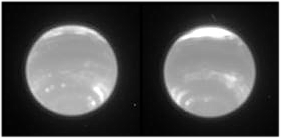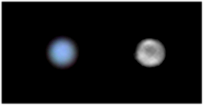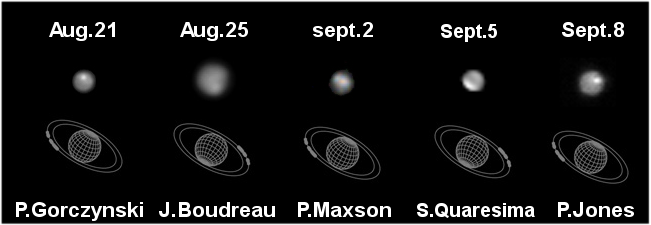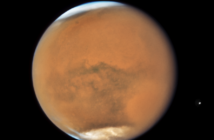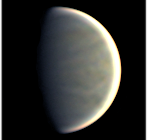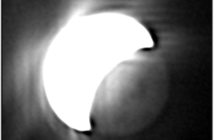In 2012 we saw the amateurs broke a new border by imaging for the first time non ambiguous details on Uranus. In 2013, this is maybe the turn of Neptune !
But what can we see on Neptune ?
Neptune is planet rather similar to Uranus: its very cold color (blue) demonstrates a strong absorption of long wavelengths (red and infrared). Like this last one, we are then going to see the most contrasted details in these color bands. The Hubble space telescope and some professional terrestrial observatories has been revealing for years incomplete belts, and spots, on the surface of Neptune. The astronomers even suspect a seasonal evolution, because those belts and spots have been intensifying noticeably in the southern hemisphere, that passed by its summer solstice in 1984 (if Neptune were Earth, it would be now in its late southern winter, end of February).
Here are two IR images taken by the HST in 2005, with a long-pass 850 nm filter, a bit deeper than those used in the amateur world, but of similar transmission regarding the details imaged. The south pole is at bottom. We clearly see those heterogeneous belts and spots in the southern hemisphere, as well as a bright limb on the winter north pole.
Copyright: STScl
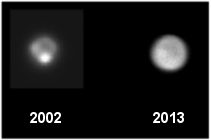
Copyright : S2P/IMCCE/OMP. Observers : Lecacheux/Frappa (2002) and Colas/Delcroix (2013)
Last results of the amateur world
Since august, 2013, we saw amateur images of Neptune that look to show as well not only a brightening on the south pole, but also a clear brighter spot. Here at left are two images taken by an amateur mission of the Society of Astronomy of Nantes last august at the T620 of the Astroqueyras observatory, a LRGB image at left and an IR at right, that shows the south brightening (orientation is still the same). Image (c) Astroqueyras/SAN/Pellier/Valeau/Manach/Tortech/Paret/Noiret.
But now we can cite some proper amateur results :) Several observers have obtained coherent data mostly with instruments of 350 mm. We can recall first the image by Damian Peach in 2010 (despite color this is a R+IR), and this year, Pete Gorczynski has been the first (to my knowledge), followed by John Boudreau (with a C11), Paul B. Jones, Steve Fugardi, Stefano Quaresima or Paul Maxson. In particular, a bright spot looks to get more attention; its coordinates would be L=10° and lat 45°S (measure by Marc Delcroix). Here are some of their images (thanks guys, and congratulations!)
Those spots and brightening correspond quite well with the pieces of belts and spots visible on professional images.
Again a new limit broken by the amateurs ?

